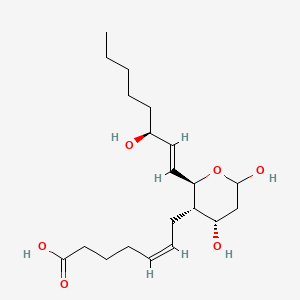| MeSH term | MeSH ID | Detail |
|---|---|---|
| Ulcer | D014456 | 16 associated lipids |
| Hypercholesterolemia | D006937 | 91 associated lipids |
| Thrombosis | D013927 | 49 associated lipids |
| Hypertension, Pulmonary | D006976 | 32 associated lipids |
| Endometriosis | D004715 | 29 associated lipids |
| Uterine Neoplasms | D014594 | 18 associated lipids |
| Myocardial Infarction | D009203 | 21 associated lipids |
| Proteinuria | D011507 | 30 associated lipids |
| Arteriosclerosis | D001161 | 86 associated lipids |
| Magnesium Deficiency | D008275 | 9 associated lipids |
| Carcinoma, Hepatocellular | D006528 | 140 associated lipids |
| Liver Cirrhosis | D008103 | 67 associated lipids |
| Fibrosis | D005355 | 23 associated lipids |
| Anemia, Sickle Cell | D000755 | 34 associated lipids |
| Fetal Diseases | D005315 | 8 associated lipids |
| Glomerulonephritis | D005921 | 35 associated lipids |
| Cerebral Hemorrhage | D002543 | 13 associated lipids |
| Sepsis | D018805 | 11 associated lipids |
| Leukopenia | D007970 | 9 associated lipids |
| Respiratory Insufficiency | D012131 | 10 associated lipids |
Thromboxane b2
Thromboxane b2 is a lipid of Fatty Acyls (FA) class. Thromboxane b2 is associated with abnormalities such as endothelial dysfunction, Diabetes Mellitus, Non-Insulin-Dependent, Diabetes Mellitus, Ischemia and Thrombocytosis. The involved functions are known as Platelet Activation, Excretory function, Anabolism, Inflammation and mRNA Expression. Thromboxane b2 often locates in Endothelium, Hepatic and Microsomes, Liver. The associated genes with Thromboxane b2 are PTGS2 gene, prothrombin fragment 2 and CCL14 wt Allele.
Cross Reference
Introduction
To understand associated biological information of Thromboxane b2, we collected biological information of abnormalities, associated pathways, cellular/molecular locations, biological functions, related genes/proteins, lipids and common seen animal/experimental models with organized paragraphs from literatures.
What diseases are associated with Thromboxane b2?
Thromboxane b2 is suspected in endothelial dysfunction, Diabetes Mellitus, Non-Insulin-Dependent, Diabetes Mellitus, Ischemia, Thrombocytosis, Acute Coronary Syndrome and other diseases in descending order of the highest number of associated sentences.
Related references are mostly published in these journals:
| Disease | Cross reference | Weighted score | Related literature |
|---|
Possible diseases from mapped MeSH terms on references
We collected disease MeSH terms mapped to the references associated with Thromboxane b2
PubChem Associated disorders and diseases
What pathways are associated with Thromboxane b2
There are no associated biomedical information in the current reference collection.
PubChem Biomolecular Interactions and Pathways
Link to PubChem Biomolecular Interactions and PathwaysWhat cellular locations are associated with Thromboxane b2?
Visualization in cellular structure
Associated locations are in red color. Not associated locations are in black.
Related references are published most in these journals:
| Location | Cross reference | Weighted score | Related literatures |
|---|
What functions are associated with Thromboxane b2?
Related references are published most in these journals:
| Function | Cross reference | Weighted score | Related literatures |
|---|
What lipids are associated with Thromboxane b2?
There are no associated biomedical information in the current reference collection.
What genes are associated with Thromboxane b2?
Related references are published most in these journals:
| Gene | Cross reference | Weighted score | Related literatures |
|---|
What common seen animal models are associated with Thromboxane b2?
There are no associated biomedical information in the current reference collection.
NCBI Entrez Crosslinks
All references with Thromboxane b2
Download all related citations| Authors | Title | Published | Journal | PubMed Link |
|---|---|---|---|---|
| Hauth J et al. | Maternal serum thromboxane B2 concentrations do not predict improved outcomes in high-risk pregnancies in a low-dose aspirin trial. The National Institute of Child Health and Human Development Network of Maternal-Fetal Medical Units. | 1998 | Am. J. Obstet. Gynecol. | pmid:9822499 |
| Saitta A et al. | Effects of picotamide on release of endothelin-1, thromboxane and prostacycline after treadmill stress in patients with peripheral artery disease. | 1998 | Angiology | pmid:9822043 |
| Menè P et al. | Eicosanoid synthesis in peripheral blood monocytes: a marker of disease activity in lupus nephritis. | 1998 | Am. J. Kidney Dis. | pmid:9820447 |
| Jiang XW et al. | Effects of low-dose Beraprost sodium, a stable prostaglandin I2 analogue, on reperfusion injury to rabbit lungs. | 1998 | Am. J. Respir. Crit. Care Med. | pmid:9817723 |
| Dobner P and Engelmann B | Low-density lipoproteins supply phospholipid-bound arachidonic acid for platelet eicosanoid production. | 1998 | Am. J. Physiol. | pmid:9814996 |
| Hellyer PW et al. | The effects of hyperoxia on the biosynthesis of cyclooxygenase products and haemodynamic response to nitric oxide synthase inhibition with L-NAME in endotoxaemic pigs. | 1998 | J. Vet. Pharmacol. Ther. | pmid:9811434 |
| Cullen L et al. | Selective cyclooxygenase-2 inhibition by nimesulide in man. | 1998 | J. Pharmacol. Exp. Ther. | pmid:9808683 |
| Huszár E et al. | Elevated circulating adenosine level potentiates antigen-induced immediate bronchospasm and bronchoconstrictor mediator release in sensitized guinea pigs. | 1998 | J. Allergy Clin. Immunol. | pmid:9802380 |
| Turpeinen AM et al. | Replacement of dietary saturated by unsaturated fatty acids: effects of platelet protein kinase C activity, urinary content of 2,3-dinor-TXB2 and in vitro platelet aggregation in healthy man. | 1998 | Thromb. Haemost. | pmid:9798986 |
| Obase Y et al. | Effects of cysteinyl-leukotriene receptor antagonist, thromboxane A2 receptor antagonist, and thromboxane A2 synthetase inhibitor on antigen-induced bronchoconstriction in patients with asthma. | 1998 | Chest | pmid:9792572 |
